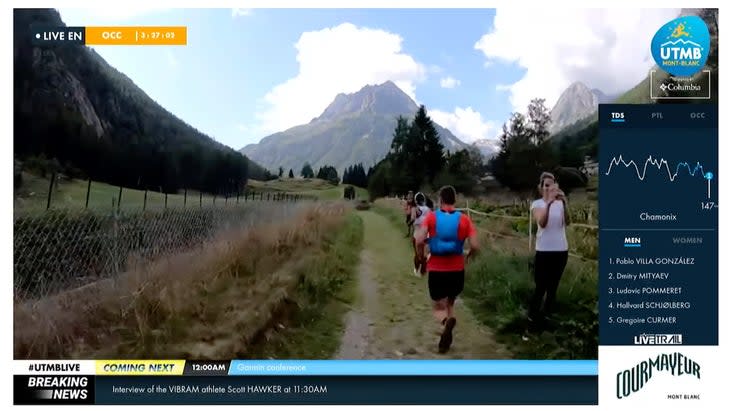How Livestreaming Will Shape the Future of Ultrarunning
This article originally appeared on Trail Runner
A 30-hour trail race may not seem, at first, like it would make a great spectator sport. The course is too long to view from one location, and progress is relatively slow. But thanks to new technologies, the age of ultrarunning livestreaming is here.
Today, ultrarunning is one of America's fastest-growing sports. On any given weekend, there are over a dozen ultrarunning events across the United States. The number of races in North America has more than doubled in the past decade, and, in 2022, there were ten times as many races as in 2002. Who would have guessed so many people want to run races of 50 or 100 miles--or, increasingly, even longer?
Despite this increasing popularity, vestiges of the sport's niche history remain. There's little prize money to be had, free camping at starting lines is common, and scruffy beards abound. Also, the infrastructure is still broadly low-tech. For some, these elements are seen as inextricable from the culture of ultrarunning. Others feel as though amateurism is holding the sport back. But things are changing as the sport grows, and the most impactful of these changes involve technology.
There's much to be said about GPS watches, sport-specific equipment, online registration, social media, and the emerging world of fantasy trail running. But the media landscape of the sport, in particular, video livestreaming, is a major technological force shaping the future of ultrarunning--not just for the runners but also for spectators. Livestreaming suggests an exciting future for ultrarunning--and it also harkens back to the sport's centuries-old roots.

The Rise of Ultrarunning Tracking and Streaming
Previously, what happened on the trail stayed on the trail. Even when online race results finally came along, they weren't posted for days after the event. The first step toward streaming was live runner tracking, online tables showing when runners passed certain checkpoints. This provided a rudimentary way to spectate these unwieldy events.
A pioneering in race tracking is UltraLive, founded by Ted Knudsen, who also owns the San Francisco Running Company. UltraLive was first used in a major event with the 2010 Western States, and today it provides free tracking services for ultramarathons. But Knudsen's vision has always been more expansive. He first attempted live race photography and video before the smartphone era, but it didn't catch on at the time.
As smartphones and action cameras such as GoPros became available, runners and photographers were increasingly able to capture footage from races and edit them into highlight videos and video-based race reports, to be published online in the days following a race.
Now, with higher bandwidth and streaming platforms such as YouTube Live and Twitch, video livestreaming has become far more accessible. One major example is the Western States Endurance Run, which began livestreaming its 2021 race. Live studio commentary accompanied footage of the course for the entire 30 hours, including predictions and stories about many of the runners on the field. Archived on YouTube, the first 10-hour part of the 2022 stream has 146,000 views, as of this writing.
Aravaipa Running has also been a frontrunner in streaming. Jamil Coury, owner of Aravaipa, points out how streaming allows even people who don't run to grow their interest in the sport, while offering die-hard fans new ways to engage with their passion, including the ability to chat live with the commentators.
"I love the challenge presented by trying to tell these stories in real time in remote areas and bringing the sport I love to a broader audience," Coury told me.
RELATED: The Illusion of Progress in Sports Technology
Indeed, the remoteness of many ultrarunning events is still a limitation for streaming. In many races, there simply isn't enough of a cell signal to send a text, let alone stream video--especially on race day with all the people around straining the infrastructure. But connectivity may become less of a problem in the near future, thanks to low-earth orbit satellite internet and products such as the Starlink Roam, a portable high-speed internet hotspot.
For a Glimpse of the Future, Look to the Past
Though ultrarunning hasn't been popular for very long, its predecessor was the supreme spectator sport in its day, with betting and prize money to match. In the late-1800s, people paid admission to watch pedestrian exhibitions, in which dandies like Edward Payson Weston circled indoor arenas for hours on end. These events drew tens of thousands of spectators, and athletes competed for prizes equivalent to hundreds of thousands of dollars in today's currency. But it wasn't just about athletics. Walking exhibitions were places to see and be seen--there was flamboyant dress, food, music, and betting.
In the emerging age of livestreaming, perhaps ultrarunning might regain some of this popular exhilaration. Pedestrianism swept the nation through the turn of the century, but it faded away when bicycle racing became more popular, and ultimately it gave way to other spectator sports such as baseball and eventually football.
Speaking of football, the media history of America's favorite sport may also hold some lessons for the future of ultrarunning. In the decades after World War II, professional American football rose from a disjointed enterprise with little money, to the behemoth organization the National Football League is today. Key to that shift was taking advantage of the emerging technology of television.
The earliest televised NFL games began in 1939, primarily using a single camera at the 50-yard line that turned to follow the ball. Today, the average NFL game uses around 20 cameras, including more than 90 at this year's Super Bowl. Along with film came innovations such as instant replay and more sophisticated game strategy. Highlight videos and commentary became ways to dramatize and further publicize the sport. Today, 16 million people watch an average regular-season football game, and Super Bowl viewership is over 100 million. As a result, more people watch football remotely than could ever attend the games live.
Ultrarunning may never be as big as football, but there is still an intriguing precedent here about the value of making smart use of emerging technology to improve a sport and engage new audiences.

The Future of Ultrarunning
Knowing now that technology plays a critical role in the popularity of sport, where might livestream technology bring ultrarunning in the future? Virtual reality and 360-degree video are still in their infancy but are poised to grow. Imagine spectating a trail race through immersive, high-definition video. More cameras on the trail could offer spectators multiple views to choose from, and drone cameras could provide ongoing views of the leaders. User experience innovations could allow viewers to watch multiple streams at once. Artificial intelligence could be used to identify particular runners and create dynamically edited video clips from the ongoing feed. Spectators could be notified when a particular runner reaches a checkpoint, passes another runner, or exceeds a certain pace.
All of these technologies already exist--they just haven't been put to use. If they are, they could create more dynamism, more excitement, and more personalization for spectators. We could also see audiences grow beyond the friends, family, and other runners, to include non-runners who enjoy spectating, similar to how most NFL spectators do not themselves play football.
Ted Knudsen, owner of UltraLive, says that streaming and tracking also offer safety benefits that shouldn't be overlooked. With better technology, race staff will know who is on the course and where, and who dropped out or may need medical attention. Currently, that information is limited and delayed.
Barriers to Growth
There are some barriers to technological adoption in the sport. First, technological issues such as battery life and connectivity are major limiting factors. Still, these have come a long way in recent years, and we can expect improvements to continue.
Next, data collection will likely remain a challenge. Knudsen says that data is always the biggest issue at ultramarathons, and it comes down to staffing. Flagship races such as Western States may have 1,500 volunteers for the 400 runners in the event, but at smaller races the proportion is reversed. With volunteers already stretched thin, it's unlikely that they'd also be available to collect data for tracking, much less operate cameras and engage with streaming platforms. As interest in the sport continues to grow, perhaps so too will volunteer involvement.
Then there's the money. Ultrarunning is a small sport, and no matter how much it grows, it's still tiny. For scale, Western States has less than 1 percent of the viewership of the average NFL game. Even Ultra Trail du Mont Blanc, which is quickly becoming a media giant, does not come close to NFL's viewership numbers. The UTMB livestream team employs world-class mountain bikers and trail runners to the lead runners around the entire 104-mile course with wireless cameras that transmit live video via backpack-mounted transponders. Last year's UTMB saw nearly 14 million views across the UTMB Live platform and official social networks throughout the whole week--that's one-tenth of the viewership of the Super Bowl just on live TV.
A smaller sport means less money to invest in new technologies and user experience for spectators. The most exciting emerging tech may always be out of reach. Ways to overcome this could include sponsorship--something that's increasing at the big races--and higher registration fees. Another path forward is for developers to create platforms that could be shared across the world of ultrarunning (not tied to just one company) and perhaps other ultra-endurance sports, such as triathlon and cycling.
Finally, there's the cultural issue. In the U.S., ultrarunning has a grassroots legacy and reputation. Races have long been cheap and no-frills, epitomized by the "fatass" race format ("no fees, no awards, no aid, no wimps"). Not everyone will accept new technology, corporate sponsorship, or higher fees. This is leading to a bifurcation in the sport between old-school, grassroots events without tracking or media to speak of, and big-ticket races with high-tech media production.
Candice Burt, founder of Destination Trail, specializes in small events without sponsorships or cutting-edge technology. She recognizes that big-ticket races will help bring newcomers into the sport, but she says that small events can be more innovative and community-oriented. "There's a future where we can balance the two seemingly competing forces," Burt said in an interview.
Bottom Line?
Indeed, ultrarunning is an expansive sport. Already it combines very different distances--a 50K is a far cry from a 200-mile race. And in any given race, elite runners are playing a different sport from the back-of-the-pack runners. That's not to say any of them are better or worse. We may admire the top finishers with sheer awe at their performance, but we also admire the Golden Hour finishers, often with tears, for what they teach us about the human spirit.
Looking again at the history, it's interesting to note that the pedestrianism craze swept the U.S. at the dawn of automation. I wonder if it's for similar reasons that ultrarunning is seeing renewed growth as we get deeper into the digital age. This time, it's not just long-distance exercise, but it's going out into nature. Are we responding to something that's missing from our lives?
In this light, infusing technology into ultrarunning may seem to many like an oxymoron. But if we consider how more attention to the sport could bring far more people into the natural world, then this may be an upside: more attention to our natural environment, more stewardship of public lands, and perhaps more balance in the digital age.
Tim Gorichanaz teaches and conducts research in the College of Computing & Informatics at Drexel University in Philadelphia. He explores the ways in which meaningful human pursuits are evolving in the digital age.
For exclusive access to all of our fitness, gear, adventure, and travel stories, plus discounts on trips, events, and gear, sign up for Outside+ today.

